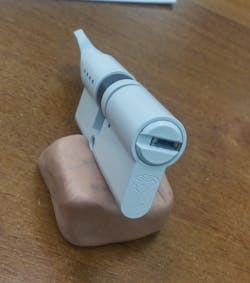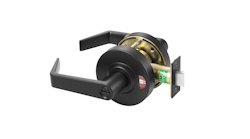Multipoint lock assemblies typically extend most of if not all the length of a door edge.
In commercial contexts, doors that have more than one locking point are used to reduce the vulnerability of an opening to forced entry. We typically think of them as three-point locks, where top and bottom rods or latches enhance the typical center locking point. For outswinging doors, this technique requires including the hinge pins to lessen their possible removal and the possibility of prying the door out of the opening from the otherwise nonlocked edge.
In residential applications, multipoint locks provide active security and help to prevent a door from warping or being pried open. Multipoint locks often are deployed on patio doors, which are constructed of plastic, fiberglass, PVC and lots of glass or clear glazing.
Obviously, this type of door in a residential structure, even an exterior wall, doesn’t provide a significant security barrier against a deliberate and professional attempt at forced entry, but a multipoint lock that’s installed properly can deter and possibly thwart a casual break-in attempt. It comes in way ahead of a broom handle or nothing at all.
When repairing, replacing or rekeying a residential multipoint lock, it helps to be familiar with its characteristics and how to source out repair parts.
Euro Cylinders
Many multipoint locks are imported and employ so-called Euro cylinders (also known as DIN cylinders), which are unfamiliar to many U.S. locksmiths. Euro cylinders are used primarily on residential doors and have a lot in common with interchangeable cores.
Mul-T-Lock USA, part of ASSA ABLOY, makes Euro cylinders and can deliver special orders, according to Product Specialist Rami Almosnino. “Our unique modular system allows us to ‘build a cylinder’ to the desired length on the spot.”
Almosnino says Euro cylinders can have a gear or cog wheel (a cam) as the means of driving the lock mechanism. The gear style typically will be the one used on a multipoint locks, he adds.
As for the cam version: “It comes single-sided, with a thumb turn on one side and key on the other, or double-sided, in which case you’ll have a key on both ends,” Almosnino explains. “This [double-sided] version is what most locksmiths find very challenging to rekey.”
Mul-T-Lock developed a technique that makes the cam Euro cylinders easier to rekey. A video is at https://www.youtube.com/watch?v=fpGO7PYn2Lg&feature=youtu.be.
The most important part of the installation process is the preparation. That’s because Euro cylinders can be prone to what’s known as “lock snapping” if installed improperly. It’s the cylinder’s big weakness, Almosnino says.
“If you do install it, make sure to use proper protection over it,” he says.
The best way to prevent snapping is by buying anti-snap locks or by installing the cylinder flush against the door, not the lock’s faceplate. With anti-snap cylinders, the lock, if it snaps, will do so in a way that doesn’t compromise the lock’s security.
Almosnino conducts classes that include Euro cylinders through Mul-T-Lock Academy. For more information, go to: www.mul-t-lock.com.
Mul-T-Lock Euro Profile Cylinder
The Euro Profile Cylinder is compatible with other manufacturers’ locks and lock cases that use a Euro cylinder. It comes with 360-degree operation by a key or a thumbturn. A key disengages the other side.
The Euro Profile Cylinder is made of high-quality brass, a steel cam and cogwheel and nickel silver and stainless steel pins. A variety of thumbturns are available. The cylinder comes in nickel satin, brass and shiny brass as standard finishes, with nickel chrome, antique brass and even white available as special finishes.
It also has 3-in-1 Keying, which allows you to change a lock’s combination up to two times by simply turning a key.
The Euro Profile Cylinder comes in Classic, Interactive+ and MT5 platforms in keyed or keyed alike. The MT5 platform is designed for maximum protection, flexibility and convenience. It has a modular cylinder, which gives installers the flexibility to quickly and easily configure cylinder lengths according to customer demands.
More info: www.mul-t-lock.com.
HOPPE Q&A
HOPPE North America specializes in precision hardware for doors and windows, including multipoint locking systems, primarily for original-equipment manufacturers and distributors.
We interviewed Scott A. Trogner, HOPPE technical product specialist, about his company’s products.
Locksmith Ledger: What makes your products unique?
Trogner: Because of our domestic manufacturing, we’re capable of producing and modifying our products to accommodate our customers’ most unique requirements, such as custom handle heights, custom door heights in excess of 14 feet and an array of locking configurations.
LL: How can a locksmith buy your products?
ST: Through regional distributors that are listed on our website: https://www.hoppe.com/us/us/service/replacement-parts-and-support.
LL: What is your best seller?
ST: The HLS 9000 multilocking system and related handles and cylinders.
LL: What are typical problems with a multipoint lock?
ST: If the door isn’t installed properly, there might be an issue. The majority of our service calls are about how to adjust for better operations or remove the 90-degree cylinder. One issue that comes up is on the secondary or inactive panel where the connection from the top to the gear is made. This is adjustable, and if the installer doesn’t pay attention, the timing between the top shoot bolt and the bottom can be off, which means that you can throw the shoot bolts into the head and sill but not lock it. To fix, you have to remove the astragal, then the top extension. Then you reconnect in the proper position and reinstall the astragal. We have instructions sheets for most issues involving the doors: How to rekey cylinders, how to remove 90-degree cylinders, how to adjust roller cams or even how to replace or assemble the top extension to the gear.
LL: My impression is the first step in servicing theses locks is identifying the make and model. What resources do you provide for this?
ST: Yes, it’s critical the correct information be provided to our distributors to assist the locksmith in identifying exactly what product they would need. Our questionnaires provide the details we need, including faceplate width, backset, handle height, overall hardware height and locking point positions.
LL: Can your multipoint locks be retrofitted?
ST: This is a difficult question. In general, it isn’t something even a general contractor can do. We replace other multipoints with the HOPPE brand but not the bored locks.
LL: Tell us about your Euro cylinders.
ST: The Euro cylinders we offer come in a variety of lengths, finishes and knob styles, all in a Schlage C5 pin key format. We also have products that use a U.S. style cylinder available in silver or brass finish, again in the Schlage C keyway.
Strybuc Q&A
Strybuc is a third-generation family-owned national distributor of all types of locks but particularly multipoint locks. We spoke with Pete Pierangeli III, Strybuc’s director of business development, about his company and multipoint locks.
Locksmith Ledger: What range of products do you offer?
Pierangeli: We sell all the hardware used on windows and doors, from sash locks to window balances to patio door rollers and screen material to multipoint hardware and commercial door hardware. We stock more than 85,000 parts in our warehouse in Philadelphia, and we have two other distribution centers in Miami and Reno, Nevada.
LL: How can a locksmith buy your products?
PP: After a locksmith is set up with an account, they call, email or text their orders in to us, or they order them directly online through the SHOP feature on our website.
LL: Where are your multipoint locks used?
PP: The majority of multipoint locks that we sell are used on swing doors typically going out to a patio, but sometimes on the front door.
LL: Which are the most popular models/types of multipoint locks?
PP: Hoppe and GU are the most popular multipoint locks on the market. Within each company’s multipoint offering, I would say the manual-tongue systems and shoot-bolt systems are the most popular styles.
LL: Do you offer Euro cylinders?
PP: Yes, we offer European profile cylinders in all sorts of colors and sizes.
LL: In your opinion, what are their strengths or drawbacks?
PP: The strength of the European profiles we offer is that all come with a Schlage C keyway, so they are easy to rekey. The drawback is they are 90-degree cylinders, and sometimes they get caught up in the wrong 90-degree profile (10 o’clock to 2 o’clock). This can be fixed easily but is a nuisance for the homeowner.
Tim O’Leary is an experienced security consultant and a regular contributor to Locksmith Ledger.
Tim O'Leary
Tim O'Leary is a security consultant, trainer and technician who has also been writing articles on all areas of locksmithing & physical security for many years.






